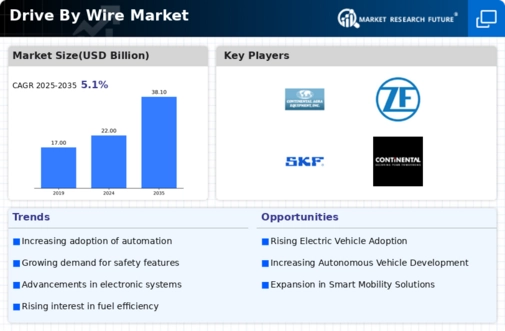Market Analysis
In-depth Analysis of Drive-by-wire Market Industry Landscape
Smart gadgets and hybrid electric cars have transformed the automotive business. Hybrid electric car sales have increased in recent years. The market has evolved due to environmental awareness and improved technologies. OEMs have developed a fuel-efficient electrification method. System operation has altered due to this approach. This technology allows the engine to switch off itself and start and stop the system using battery power. The rise of self-driving vehicles is pushing the drive wire market. Driverless-car-friendly equipment were utilized. Passengers are safer and automobiles pollute less. The market has developed due to government and top office regulations. Vehicle emissions rules have encouraged manufacturers to employ lighter materials and electrical equipment, reducing fuel usage. Today's lighter cars utilize less energy. Coronavirus outbreak in China in December 2019. It expanded worldwide fast. Lockdowns affected the world's best. The WHO claimed it will spread and be untreatable shortly. Thus, the government had to impose tight controls. Many businesses and manufacturers were impacted by this epidemic. It affected people's behavior and social life. Supply chain management was delayed due to restricted import-export negotiations between the nations.
The auto industry has also suffered. Many vehicle firms closed owing to a drop in sales. The company strategies must be altered to recoup losses and focus on raw material and other expenditures. Supply contracts and product advancements will likely drive the auto industry after 2020. Several market aspects drive the Drive By Wire (DBW) industry's trends and growth. The automotive industry's ongoing technological advancement drives this sector. As automobiles convert to electrical and computerized controls, Drive By Wire systems become increasingly prevalent. Modern automobiles must be safer, more fuel-efficient, and smarter. This move is due to requirements. Environmental awareness is another major driver of the Drive By Wire industry. Drive By Wire technology is essential for the auto industry to reduce its carbon footprint. Electronic automobile task control improves power management, reducing fuel use and emissions. Thus, rigorous smog-reduction and cleaner transportation legislation boost the DBW industry. The growing demand for ADAS and autonomous automobiles also affects market dynamics. Drive By Wire systems enable these future automotive innovations. Electronic control systems are key to semi-autonomous and driverless driving. Drive By Wire is essential for future autos. This tendency will certainly grow as more consumers seek automobiles with smart technologies that make them safer and simpler to operate. Global economic variables including GDP growth, personal income, and consumer purchasing behaviors impact the Drive By Wire industry. When the economy is good, consumers have more money to spend on automobiles with advanced technology like Drive By Wire systems. However, a weak economy might make people lose trust in the future, reducing desire for new automobiles and technology. Market competitiveness in the automobile industry influences Drive By Wire utilization. The market becomes more competitive as carmakers install computer control systems. Competitiveness generates new ideas and decreases the cost of innovative technology, allowing more automobile kinds and manufacturers to employ them. Drive By Wire is also affected by regulations and standards. Governments worldwide are prioritizing automotive safety and environmental rules. These requirements generally need sophisticated electrical control systems. Drive By Wire technology is increasingly more needed. Supply chain changes like essential component and raw material availability impact the Drive By Wire market. Supply chain issues like electronic component shortages or pricing fluctuations might impact the market. These factors impact the cost of making Drive By Wire automobiles, which affects their overall price. Lastly, the Drive By Wire industry is directly related to many other developments. Technology, environmental concerns, client preferences, the economy, competition, laws and regulations, and the supply chain impact this market. As the auto industry evolves, the Drive By Wire market will drive innovation and shape vehicle technology.







Leave a Comment